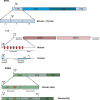TFs for TEs: the transcription factor repertoire of mammalian transposable elements
- PMID: 33397727
- PMCID: PMC7778262
- DOI: 10.1101/gad.344473.120
TFs for TEs: the transcription factor repertoire of mammalian transposable elements
Abstract
Transposable elements (TEs) are genetic elements capable of changing position within the genome. Although their mobilization can constitute a threat to genome integrity, nearly half of modern mammalian genomes are composed of remnants of TE insertions. The first critical step for a successful transposition cycle is the generation of a full-length transcript. TEs have evolved cis-regulatory elements enabling them to recruit host-encoded factors driving their own, selfish transcription. TEs are generally transcriptionally silenced in somatic cells, and the mechanisms underlying their repression have been extensively studied. However, during germline formation, preimplantation development, and tumorigenesis, specific TE families are highly expressed. Understanding the molecular players at stake in these contexts is of utmost importance to establish the mechanisms regulating TEs, as well as the importance of their transcription to the biology of the host. Here, we review the transcription factors known to be involved in the sequence-specific recognition and transcriptional activation of specific TE families or subfamilies. We discuss the diversity of TE regulatory elements within mammalian genomes and highlight the importance of TE mobilization in the dispersal of transcription factor-binding sites over the course of evolution.
Keywords: co-option; regulatory elements; retrotransposons; transcriptional regulation.
© 2021 Hermant and Torres-Padilla; Published by Cold Spring Harbor Laboratory Press.
Figures


References
Publication types
MeSH terms
Substances
LinkOut - more resources
Full Text Sources
Other Literature Sources
